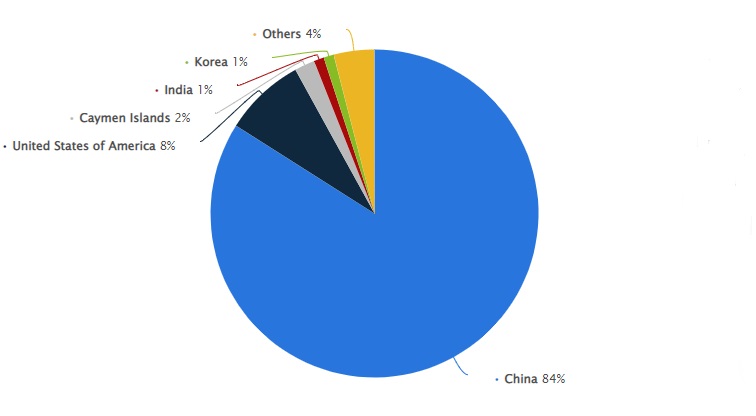Entrepreneurs in China are filing more blockchain patents than any nation on Earth, but only a fraction of those applications are being approved.
According to Jianwei Wang, the deputy director at the Ministry of Industry and Information Technology, Chinese blockchain patents account for 84% of the world’s total.
In an announcement subsequently reported by the South China Morning Post, Wang said that blockchain, “accelerates integration with the economy, services for people’s livelihoods, smart cities and administrative services”.
Wang did not specify over what time period his 84% claim was measured, but his comments do align with a Statista report in Jan. which measured the distribution of global blockchain patents over 2021.
That is only one part of the story, however. One potential point of concern for Chinese growth is that only a fraction of those patents are good enough to win final approval.
Further data suggests that less of those approved patents go on to become successful products than in competitor nations such as the U.S. or South Korea.

A highly confusing and frustrating system
In China, cryptocurrency remains subject to a nationwide ban, but the underlying blockchain technology is not. The mining of cryptocurrency is also banned, forcing operations underground.
Meanwhile, a Chinese court recently found that the ownership and trading of cryptocurrency is protected by law, as long as that cryptocurrency is traded as property and not currency, because cryptocurrency cannot be currency, and therefore it isn’t.
Such mind-bending semantics suggest that if the Chinese Communist Party (CCP) was to abolish singing in the rain, Chinese innovators and lawmakers would eventually find a way to dance between the raindrops.
China’s burdensome and oppressive edicts have resulted in a highly centralized environment in which the country is far ahead of the technology curve in certain areas such as its digital yuan, but where innovation is frustrated elsewhere.
State-backed projects including the CBDC-related Blockchain Service Network (BSN), continue to do well in China’s domestic market.
The network now operates 28 blockchain frameworks, with 3,000 total apps created by a 25,00 strong army of developers. Major industry players such as Emperor Group, HSBC, Lan Kwai Fong Group and Maxim’s Group are among its customers.
BSN now has plans to build on its success and become an international force, but it may find significant challenges to overseas adoption.
In other technology areas, such as 5G, governments, including the U.S. and the U.K., have banned Chinese technology. The perception is that state-backed Chinese companies are too closely tied to the CCP and therefore pose a major security threat.
China patents face significant challenges
While state-backed blockchain innovators face roadblocks from cautious overseas governments, the Chinese patent system also has its own issues to tackle. While only 19% of Chinese patent applications are approved, in the U.S. that figure is a far higher 26%. In South Korea, patent approval is a massive 45%.
This according to a 2021 report by PatSnap which examined blockchain innovation and its patents, and from a Chinese perspective, not all of its findings were for the good. The report compared and contrasted patents from nations from around the world including China, The U.S. and South Korea.
As of Oct. 2021, PatSnap found there were 55,000 global blockchain patents.
The report (auto translated from the Chinese) was subtly critical in that it said, “China is currently the country with the largest number of patent applications in this field, with about 33,000 pieces, accounting for about 63.2%, but the quality of patents still has room for development.”
That quality issue is one of major importance, and it tarnishes some of the sheen from China’s blockchain figures.
Citations needed
One of the ways in which the quality of a patent can be measured is in the number of citations it receives. Citations may indicate that a specific patent or technology led to further useful innovation.
With Chinese innovators filing more patents than anyone else, it might be logical to assume that Chinese patents would also have more citations than anyone else, as each innovation builds upon another. In fact, precisely the opposite is true.
In the category of the most successful patents in the industry, measured as those which are cited over 100 times or more, U.S. innovators are 13 times more successful than China.
As PatSnap goes on to say, “it is worth noting that 1.3% of the patents in the United States have been cited more than 100 times, indicating that the relevant technological innovations are very high and influential, and are generally recognized by the industry. Only 0.1% of blockchain patents in China are cited more than 100 times.”
Overall the data suggest that patents in the U.S. and South Korea, although far less voluminous, are of a better overall quality.
In short, sometimes quality really is better than quantity.
 beincrypto.com
beincrypto.com